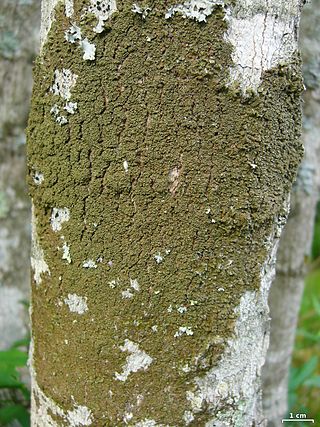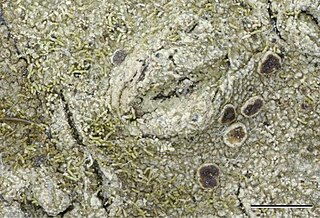
Parmelia is a genus of medium to large foliose lichens. It has a global distribution, extending from the Arctic to the Antarctic continent but concentrated in temperate regions. There are about 40 species in Parmelia. In recent decades, the once large genus Parmelia has been divided into a number of smaller genera according to thallus morphology and phylogenetic relatedness.

The Parmeliaceae is a large and diverse family of Lecanoromycetes. With over 2700 species in 71 genera, it is the largest family of lichen-forming fungi. The most speciose genera in the family are the well-known groups: Xanthoparmelia, Usnea, Parmotrema, and Hypotrachyna.

Pseudephebe is a genus of fruticose lichens in the family Parmeliaceae. It contains three species that grow on rocks.

Masonhalea is a genus of two species of lichenized fungi in the family Parmeliaceae.

Melanohalea is a genus of foliose lichens in the family Parmeliaceae. It contains 30 mostly Northern Hemisphere species that grow on bark or on wood. The genus is characterized by the presence of pseudocyphellae, usually on warts or on the tips of isidia, a non-pored epicortex and a medulla containing depsidones or lacking secondary compounds. Melanohalea was circumscribed in 2004 as a segregate of the morphologically similar genus Melanelia.

Melanelixia is a genus of foliose lichens in the family Parmeliaceae. It contains 15 Northern Hemisphere species that grow on bark or on wood. The genus is characterized by a pored or fenestrate epicortex, and the production of lecanoric acid as the primary chemical constituent of the medulla. Melanelixia was circumscribed in 2004 as a segregate of the related genus Melanelia.

Parmelinella is a genus of lichen belonging to the family Parmeliaceae. The genus was circumscribed in 1987 by John Elix and Mason Hale as a segregate of Parmelina, from which it differs in having larger ascospores and containing salazinic acid. Although the genus had been assumed to be well-defined morphologically, a 2021 molecular phylogenetic study suggests that the generic delimitations need to be revised.

Parmotrema is a genus of lichen belonging to the family Parmeliaceae. It is a large genus, containing an estimated 300 species, with a centre of diversity in subtropical regions of South America and the Pacific Islands.

Punctelia is a genus of foliose lichens belonging to the large family Parmeliaceae. The genus, which contains about 50 species, was segregated from genus Parmelia in 1982. Characteristics that define Punctelia include the presence of hook-like to thread-like conidia, simple rhizines, and point-like pseudocyphellae. It is this last feature that is alluded to in the vernacular names speckled shield lichens or speckleback lichens.

Relicina is a genus of foliose lichens belonging to the large family Parmeliaceae. It contains 59 species.
Parmotrema albinatum is a species of foliose lichen in the family Parmeliaceae that is found in Hawaii. It was originally described in 2001 as Rimelia albinata. Later phylogenetic analysis demonstrated that the genus Rimelia was synonymous with Parmotrema, so this species was transferred to that genus. The lichen is characterized by the sorediate and short-lacinulate thallus with salazinic acid in the medulla and traces of lobaric acid. The upper surface of the thallus is whitish, which probably a result of the thickness of the thick upper cortex.
Nipponoparmelia is a genus of five species of lichen belonging to the family Parmeliaceae. Nipponoparmelia was originally conceived by Syo Kurokawa as a subgenus of the genus Parmelia in 1994. It was raised to generic status in 2010. Four east Asian species were originally placed in the genus; Nipponoparmelia perplicata, found in South Korea and Russia, was added in 2014.
Emodomelanelia is a lichen genus in the family Parmeliaceae. It is monotypic, containing the single foliose Himalayan species Emodomelanelia masonii.

Notoparmelia is a genus of foliose lichens in the family Parmeliaceae. It includes 18 species that grow on bark and rocks, and are mostly distributed in the Southern Hemisphere. The genus was created in 2014 as a segregate of Parmelia.
Austromelanelixia is a genus of five species of foliose lichens in the family Parmeliaceae. All species are found in the Southern Hemisphere.

Neoprotoparmelia is a genus of crustose lichens that was created in 2018. It contains 24 tropical and subtropical species that mostly grow on bark. Neoprotoparmelia is in the subfamily Protoparmelioideae of the family Parmeliaceae, along with the morphologically similar genera Protoparmelia and Maronina.
Melanohalea zopheroa is a species of lichen in the family Parmeliaceae. It was first formally described in 1977 by Ted Esslinger as Parmelia zopheroa. A year later, he transferred it to the new genus Melanelia, which he created to contain the brown Parmeliae species. In 2004, after early molecular phylogenetic evidence showed that Melanelia was not monophyletic, Melanohalea was circumscribed by lichenologists Oscar Blanco, Ana Crespo, Pradeep K. Divakar, Esslinger, David L. Hawksworth and H. Thorsten Lumbsch, and M. zopheroa was transferred to it. The lichen has a disjunct distribution, as it is found in South America (Chile) and in New Zealand.

Xanthoparmelia loxodes is a species of foliose lichen in the family Parmeliaceae. It was first formally described by Finnish botanist William Nylander in 1872, as Parmelia loxodes. In 1978, Ted Esslinger created the genus Neofuscelia, which contained species previously classified in Parmelia subgenus Neofusca; Neofuscelia loxodes was one of many species transferred here. In a 2004 molecular phylogenetic study published by Oscar Blanco, Ana Crespo, John A. Elix, David L. Hawksworth and H. Thorsten Lumbsch, they showed that Neofuscelia did not form a clade distinct from Xanthoparmelia, and they reduced it to synonymy under Xanthoparmelia.
Parmelia isidiiveteris is a fossilised species of foliose lichen in the family Parmeliaceae. It was found in Dominican amber and described as a new species in 2000. It was tentatively placed in the genus Parmelia although its true generic placement is difficult to determine with only a single specimen available for analysis.













